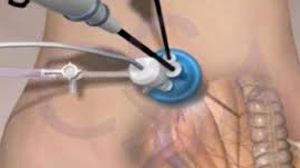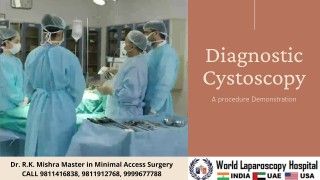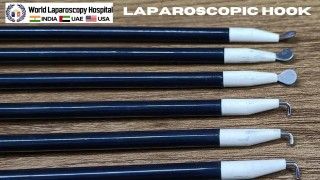Unlocking Relief: Laparoscopic Heller's Myotomy Paves the Way to Freedom from Esophageal Struggles
Add to
Share
771 views
Report
1 year ago
Description
Living with the challenges of esophageal struggles can be an overwhelming and debilitating experience. For individuals afflicted with conditions like achalasia, a disorder that disrupts the normal movement of food through the esophagus, every meal can be a battle. However, a glimmer of hope shines through in the form of a groundbreaking procedure known as laparoscopic Heller's myotomy. This advanced surgical technique is changing lives by providing a path to freedom from the clutches of esophageal limitations. Gone are the days when traditional open surgery was the only option for treating achalasia. Laparoscopic Heller's myotomy has revolutionized the field of esophageal surgery, offering a less invasive and more efficient approach to resolving the underlying issues. By utilizing small incisions and employing a laparoscope—a slender tube equipped with a camera and surgical instruments—surgeons can precisely perform myotomies, which involve cutting the muscles of the lower esophageal sphincter. This targeted intervention aims to alleviate the obstruction and restore normal esophageal function, leading to improved swallowing and relief from symptoms such as regurgitation, chest pain, and difficulty in eating. One of the key advantages of laparoscopic Heller's myotomy is its minimally invasive nature. Compared to traditional open surgery, this approach entails smaller incisions, reduced trauma to surrounding tissues, and minimal scarring. Patients undergoing laparoscopic procedures often experience less post-operative pain, shorter hospital stays, and faster recovery times. The decreased risk of complications, such as infection and herniation, further enhances the safety and effectiveness of this procedure. By embracing laparoscopic techniques, patients can regain their quality of life more swiftly, returning to their daily activities and enjoying a wider variety of foods without discomfort. The success rate of laparoscopic Heller's myotomy is truly remarkable. Numerous studies have shown that a significant majority of patients experience substantial improvement in their symptoms after the procedure. The restoration of normal esophageal function not only improves quality of life but also enhances nutrition and overall well-being. For individuals who have struggled for years with the limitations imposed by achalasia, laparoscopic Heller's myotomy provides a renewed sense of freedom, enabling them to savor meals without fear and embrace a more vibrant and fulfilling lifestyle. It is important to emphasize that laparoscopic Heller's myotomy requires the expertise of skilled surgeons who specialize in minimally invasive techniques. Consulting with a knowledgeable healthcare professional is essential to determine whether this procedure is appropriate for your specific condition. They will assess your medical history, conduct thorough evaluations, and guide you through the treatment options, ensuring the best course of action for your individual needs. Living with esophageal struggles can be a daily battle, affecting not only your physical health but also your overall well-being. For individuals plagued by conditions such as achalasia, a rare disorder that disrupts the normal movement of food through the esophagus, every swallow becomes a challenge. However, there is a glimmer of hope on the horizon—a groundbreaking surgical procedure known as laparoscopic Heller's myotomy. This advanced technique is revolutionizing the field of esophageal surgery and providing a pathway to freedom from the clutches of esophageal limitations. In the not-so-distant past, traditional open surgery was the only option for treating achalasia. However, the advent of laparoscopic Heller's myotomy has transformed the landscape, offering a less invasive and more efficient approach to resolving the underlying issues. The procedure involves accessing the esophagus and the lower esophageal sphincter through small incisions, using a laparoscope—a thin, flexible tube equipped with a camera and specialized surgical instruments. This allows surgeons to perform precise myotomies, which involve cutting the muscles of the lower esophageal sphincter to relieve the obstruction and restore normal esophageal function. What sets laparoscopic Heller's myotomy apart is its minimally invasive nature. Unlike traditional open surgery, which requires large incisions and extensive tissue manipulation, laparoscopic procedures involve smaller incisions, reduced trauma to surrounding tissues, and minimal scarring. The laparoscope provides surgeons with enhanced visualization, allowing for precise movements and improved surgical accuracy. As a result, patients undergoing laparoscopic Heller's myotomy experience less post-operative pain, shorter hospital stays, and faster recovery times. The decreased risk of complications, such as infection and herniation, further underscores the safety and effectiveness of this procedure. The benefits of laparoscopic Heller's myotomy extend beyond the physical realm. Individuals who have struggled for years with the limitations imposed by achalasia often face psychological and emotional challenges associated with their condition. The restoration of normal esophageal function following the procedure not only improves their ability to swallow but also enhances their overall quality of life. Imagine being able to savor a variety of foods without fear, share meals with loved ones without restrictions, and experience the joy of eating without discomfort. Laparoscopic Heller's myotomy opens doors to these possibilities, allowing individuals to embrace a more vibrant and fulfilling lifestyle. Numerous studies have shown that laparoscopic Heller's myotomy boasts an impressive success rate. A significant majority of patients experience substantial improvement in their symptoms, such as regurgitation, chest pain, and difficulty swallowing. The procedure effectively addresses the root cause of achalasia, allowing for the free passage of food through the esophagus. As a result, patients can enjoy improved nutrition, reduce their reliance on dietary modifications, and regain control over their eating habits. It is essential to highlight that laparoscopic Heller's myotomy is a highly specialized procedure that requires the expertise of skilled surgeons with extensive training in minimally invasive techniques. Consulting with a knowledgeable healthcare professional is crucial to determine whether this procedure is suitable for your specific condition. They will carefully evaluate your medical history, conduct thorough examinations, and guide you through the treatment options, ensuring the best course of action tailored to your individual needs. In conclusion, laparoscopic Heller's myotomy stands as a beacon of hope for individuals burdened by esophageal struggles caused by conditions like achalasia. This innovative procedure offers not only a targeted solution to the root cause of the problem but also a multitude of benefits over traditional open surgery. With its minimally invasive approach, high success rates, and improved post-operative outcomes, laparoscopic Heller's myotomy opens doors to a life free from the constraints of esophageal limitations. Reach out to your healthcare provider today, unlock the relief you deserve, and embark on a journey towards a liberated and fulfilling future.
Similar Videos






